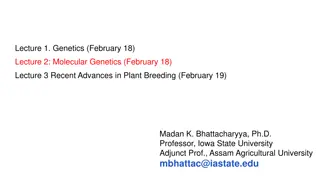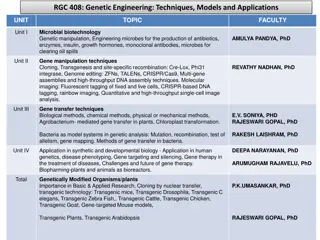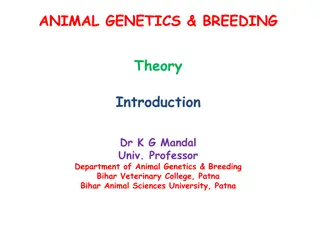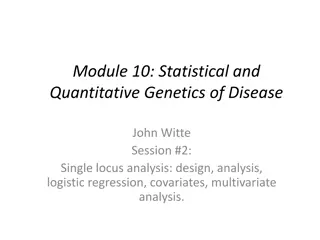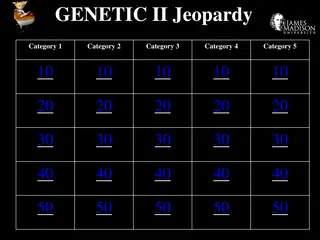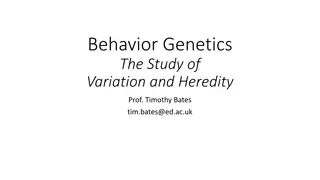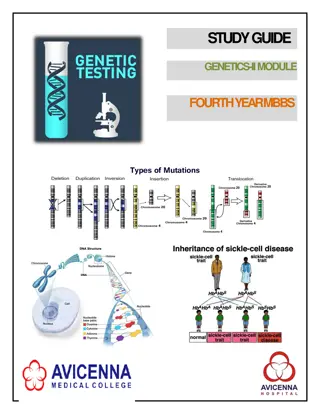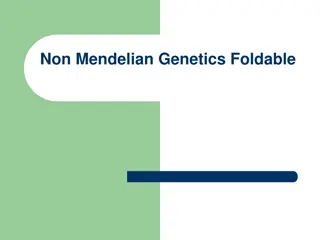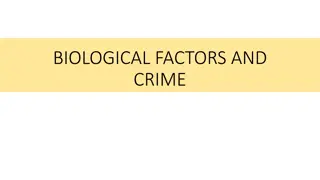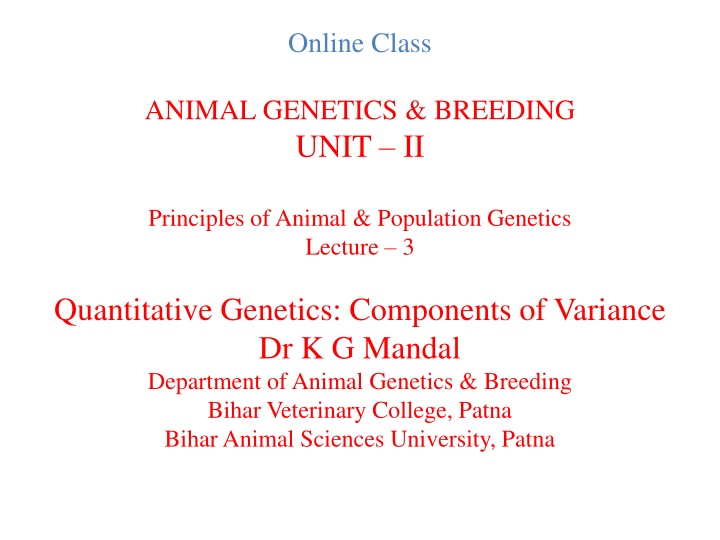
Qualitative and Quantitative Genetics in Animal Breeding
Explore the differences between qualitative and quantitative genetics in animal breeding, focusing on traits, inheritance mechanisms, measurement methods, and analysis tools. Gain insights into polygenic traits, gene effects, variation types, and the influence of genetic and environmental factors on trait expression.
Uploaded on | 2 Views
Download Presentation

Please find below an Image/Link to download the presentation.
The content on the website is provided AS IS for your information and personal use only. It may not be sold, licensed, or shared on other websites without obtaining consent from the author. If you encounter any issues during the download, it is possible that the publisher has removed the file from their server.
You are allowed to download the files provided on this website for personal or commercial use, subject to the condition that they are used lawfully. All files are the property of their respective owners.
The content on the website is provided AS IS for your information and personal use only. It may not be sold, licensed, or shared on other websites without obtaining consent from the author.
E N D
Presentation Transcript
Online Class ANIMAL GENETICS & BREEDING UNIT II Principles of Animal & Population Genetics Lecture 3 Quantitative Genetics: Components of Variance Dr K G Mandal Department of Animal Genetics & Breeding Bihar Veterinary College, Patna Bihar Animal Sciences University, Patna
Qualitative vs. Quantitative Genetics 1. Quantitative Genetics is the inheritance of those difference individuals which are of degree rather than kind, rather than qualitative. 1. Qualitative Genetics is the study of inheritance of those which are qualitative in nature. study of characters between quantitative 2. Qualitative characters follow discontinuous variation 2. Quantitative characters follow variation. continuous
3. Inheritance of quantitative characters is controlled by a large number of genes called polygenes, hence character polygenic traits. 3. Inheritance of qualitative characters is controlled by one, two or a very few number of genes. are called 4. Effect of individual gene is so prominent that its presence can be visible in the trait, for which those genes are called major gene. 4. Effect of individual gene is very small appreciable. effect of all the genes exhibits in the character, for which the polygenes are also called minor genes. and cumulative not
5. Quantitative traits can be measured/quantified through metric units (Kg., g., ml, mm, cm, ltr, etc.) for which they are also known as quantitative traits/biometric traits. 5. Qualitative traits can not be measured. 6. Qualitative traits can be analysed square test only. 6. Quantitative traits are analysed through statistical tools, like mean, variance, SD, SE, correlation, ANOVA etc. through chi- regression,
7. Classical medallion phenotypic can not be seen. 7. The classical mendelian phenotypic ratios can be seen groups due to effect of a single difference at a given locus. 8. Does not influence by environment. ratios between gene 8. Influenced through the effect environment. of
Qualitative vs Quantitative Genetics Measurement of characters : Biometric or non-biometric. No. of genes involved Effect of genes Types of variation Distribution Causes of variation Method of analysis : One, Two or Polygene : Major or Minor : Continuous or discontinuous : Normal or Binominal. : Genetic or environment or both :chi-square/Mean, SE, SD, Correlation, regression, ANOVA .
Values and Means P = G + E Where, P = Phenotypic value G = Genotypic value E = Environmental deviation Value assigned to the genotypes A2A2 -a 0 A1A2 d A1A1 +a
Population Mean For a single locus M = a(p - q) + 2pqd M = population mean a = assigned homozygotes. d = degree of dominance assigned to heterozygote. if d = 0, then M = a (1 2q) if d = a, then M = a (1 2q2) if A1 is fixed (p = 1), then M = a if A2 is fixed (q = 1), then M = -a genotype value of
Since, quantitative traits are influenced by the genes situated at many loci then, M = a(p q) + 2 pqd. If all the genes that increase the value are fixed, then population mean, M = + a and vice versa , (M = - a).
Calculation of population Mean Genotype Frequency Genotypic Freq x Value ap2 2pq -aq2 Value a d -a Sum = ap2 + 2pq aq2 = a(p q) + 2pqd A1A1 A1A2 A2A2 p2 2pq q2
Genotypic value It is measured as a deviation from the population mean Genotype Assigned Values a GV deviated from population mean a M= a [(p q) + 2pqd] = 2q ( a pd) d M = d [(p q) + 2pqd] = a (q p) + d (1 2pq) -a M = -a [(p q) + 2pqd] = -2p (a +qd) A1A1 A1A2 d A2A2 -a Mean genotypic value = 0 (zero)
Average effect of Gene It is the mean deviation from the population mean of individuals which have received that gene from one parent the gene received from other parent having the at random from the population. Gene Frequency Average effect A1 p X1 A2 q X2 A1= A1 Gene A2= Genotype Frequency Value A1A1 p a A1A2 q d ____________________________________________________________ Mean GV of A1A1 & A1A2 = ap + qd The average effect of A1 = X1 = (ap+qd)-[a(p-q)+2pqd] =ap+qd-a(p-q)-2pqd =ap+qd-ap-aq-2pqd =aq+qd-2pqd =q[a+d-2pd] =q[a+d(1-2p} =q[a+d(p+q-2p)] =q[a+d(q-p)] GV ap qd
A1=A1A2 A2 Gene Genotype A1A2 A2A2 _____________________________________________________________ A2=A2A2 Frequency p q Value d -a GV pd -aq Genotypic value of A1A2 & A2A2 = pd-aq Average effect of A2=X2 =-pd-aq -[a(p-q)+2pqd] = pd- aq ap +aq - 2pqd = p[-a+d-2qd] = -p[a-d(p+q-2q)] = -p[a+d(q-p)] Thus, X1 = q[a+d(q-p)] X2 = -p[a+d(q-p)]
Average effect of gene in terms of gene substitution. Suppose, x=average effect of gene in terms of gene substitution & A2 is substituted by A1. Genotype Freq. Thus, A1A2 A1A1 d a p Amount of change = p(a-d) A2A2 A1A2 Freq. -a d q Overall change in mean genotypic value = p(a-d)+q(d+a) = ap-pd+qd+aq = a(P+q)+qd-pd = a+d(q-p) Thus, X1=qX X2=qX Amount of change p(a-d) q(d-(-a)) =q(d+a)
Breeding Value Breeding value is the value associated with the genes carried by an individual. Breeding value can also be judged by the mean phenotypic value of its progeny. If an individual is mated to a number of individuals taken at random from the population, then its breeding value is twice the mean deviation from the population mean. In terms of average effect of gene, the breeding value of an individual is equal to sum of the average effect of genes it carries, the summation being made over the pair of alleles at each locus and over all loci.
For a single locus with tow alleles A1 & A2, the breeding values of three genotypes will be as follows: Genotype Breeding Value A1A1 2 1 = 2q A1A2 1+ 2 = (q-p) A2A2 2 2 = - 2p The mean breeding value is equal to zero.
Components of variance Population mean gives no idea about the phenotypic value recorded on different individuals. Measures of dispersion tells about scaterness of the observations in a set of data. Variance is an important components of measures of dispersion because of its two important properties: Additivity Sub divisibility
When values are expressed as deviation from the population mean, the mean of the squared deviation is known as variance. Where, variance (s2) = 1/N (xi-x)2 x = population mean xi = x1, x2, x3, xN Variance can be sub divided or partitioned into different components according to different causes of variation.
Phenotypic value of an individual depends on its genotypic value and environment in which it is subjected as well as interaction between genotype and phenotype. Thus, P = G + E P2 = (G + E)2 = G2 +E2 +2GE Where, P = Phenotypic value, G = Genotypic value, E = Environmental deviation. Since, all values are taken as deviation from the population mean, then VP=VG+VE+2COVGE In absence of interaction between genotype and environment, VP=VG+VE
Genotypic value, depends on breeding value, dominance deviation and gene interaction, then G = A + D + I To find out important causes of genetic variation the genotypic variance is to be partitioned according to different causes of variation, i.e. VG = VA+ VD+VI There are two different kinds of environmental factors which may influence phenotype, they are: 1. General environmental variance, VEg 2. Special environmental variance, VEs Hence, VE = Veg + VEs Thus, VP=VG+VE =VA+VD+VI+VE =VA+VD+VI+VEg+VEs
Importance of variance & its components Variance can be partitioned into different components corresponding to its causing factors. Partitioning of variance is useful to know the effect of different factors causing the variation in the character. To estimate the percent contribution of different causing factors to the total phenotypic variance. To estimate the relative importance of different causing factors as a proportion of the total phenotypic variance.


